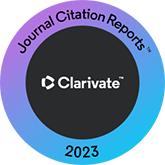Age and gender effects in European Portuguese spontaneous speech
DOI:
https://doi.org/10.3989/loquens.2021.077Keywords:
aging, spontaneous speech, rhythm, speaking fundamental frequencyAbstract
Aging is part of the normal evolution of human beings. However, the knowledge about speech in the older ages is still dispersed and incomplete. Considering conflicting findings reported in prior research, this study aims to contribute to increase our knowledge about age effects on the spontaneous speech of Portuguese adults. In order to analyze the effects of age on rhythmic, intonation and voice quality domains, several parameters were extracted from spontaneous speech produced by 112 adults, aged between 35 and 97. Data were obtained through a picture description task. The results showed that the most consistent age-related effects are an increase in speech pauses, mainly in men, and a Harmonics-to-Noise Ratio (HNR) decrease in women. Speaking fundamental frequency (f0) tends to decrease in women and to slightly increase in men with age. These findings for Portuguese are in line with previous research suggesting that suprasegmental characteristics of speech change with age, with some gender differences.
Downloads
References
Albuquerque, L., Oliveira, C., Teixeira, A., Sa-Couto, P., & Figueiredo, D. (2019). Age-related changes in European Portuguese vowel acoustics. INTERSPEECH, 3965-3969. Graz, Austria: ISCA. https://doi.org/10.21437/Interspeech.2019-1818
Albuquerque, L., Oliveira, C., Teixeira, A., Sa-Couto, P., & Figueiredo, D. (2020). A comprehensive analysis of age and gender effects in European Portuguese oral vowels. Journal of Voice, In press.
Albuquerque, L., Oliveira, C., Teixeira, A., Sa-Couto, P., Freitas, J., & Dias, M. S. M. S. (2014). Impact of age in the production of European Portuguese vowels. INTERSPEECH, 940-944. Singapore. https://doi.org/10.21437/Interspeech.2014-244
Albuquerque, L., Valente, A. R. S., Teixeira, A., Oliveira, C., & Figueiredo, D. (2021). Acoustic changes in spontaneous speech with age. VIII Congreso Internacional de Fonética Experimental, 3. Girona.
Ambreen, S., Bashir, N., Tarar, S. A., & Kausar, R. (2019). Acoustic analysis of normal voice patterns in Pakistani adults. Journal of Voice, 33(1), 124.e49-124.e58. https://doi.org/10.1016/j.jvoice.2017.09.003 PMid:29033256
Barbosa, P. A. (2006). Incursões em torno do ritmo da fala (Incursions around the rhythm of speech). Campinas: FAPESP/Pontes Editores.
Barbosa, P. A. (2010). Automatic duration-related salience detection in Brazilian Portuguese read and spontaneous speech. Speech Prosody. Chicago.
Barbosa, P. A. (2013). Semi-automatic and automatic tools for generating prosodic descriptors for prosody research. TRASP, 86-89. Aix-en-Provence.
Bourbon, A., & Hermes, A. (2020). Have a break: Aging effects on sentence production and structuring in French. 12th International Seminar on Speech Production.
Brückl, M., & Sendlmeier, W. (2003). Aging female voices: an acoustic and perceptive analysis. VOQUAL'03, pp. 163-168.
Cannizzaro, M., Harel, B., Reilly, N., Chappell, P., & Snyder, P. J. (2004). Voice acoustical measurement of the severity of major depression. Brain and Cognition, 56(1), 30-35. https://doi.org/10.1016/j.bandc.2004.05.003 PMid:15380873
de Jong, N. H., & Wempe, T. (2009). Praat script to detect syllable nuclei and measure speech rate automatically. Behavior Research Methods, 41(2), 385-390. https://doi.org/10.3758/BRM.41.2.385 PMid:19363178
Dehqan, A., Scherer, R. C., Dashti, G., Ansari-Moghaddam, A., & Fanaie, S. (2013). The effects of aging on acoustic parameters of voice. Folia Phoniatrica et Logopaedica, 64(6), 265-270. https://doi.org/10.1159/000343998 PMid:23328404
Draxler, C., & Jänsch, K. (2017). SpeechRecorder (3.12.0).
Dunashova, A. (2021). Intraspeaker variability of a professional lecturer: Ageing, genre, pragmatics vs. voice acting (Case study). International Conference on Speech and Computer, 179-189. https://doi.org/10.1007/978-3-030-87802-3_17
Eichhorn, J. T., Kent, R. D., Austin, D., & Vorperian, H. K. (2018). Effects of aging on vocal fundamental frequency and vowel formants in men and women. Journal of Voice, 32(5), 644.e1-644.e9. https://doi.org/10.1016/j.jvoice.2017.08.003 PMid:28864082 PMCid:PMC5832520
Escudero, P., Boersma, P., Rauber, A. S., & Bion, R. A. H. (2009). A cross-dialect acoustic description of vowels: Brazilian and European Portuguese. J. Acoust. Soc. Am., 126(3), 1379-1393. https://doi.org/10.1121/1.3180321 PMid:19739752
Ferrand, C. T. (2002). Harmonics-to-Noise Ratio: An index of vocal aging. Journal of Voice, 16(4), 480-487. https://doi.org/10.1016/S0892-1997(02)00123-6 PMid:12512635
Gerstenberg, A., Fuchs, S., Kairet, J. M., Frankenberg, C., & Schröder, J. (2018). A cross-linguistic, longitudinal case study of pauses and interpausal units in spontaneous speech corpora of older speakers of German and French. Speech Prosody. https://doi.org/10.21437/SpeechProsody.2018-43
Goodglass, H., & Kaplan, E. (1983). The Assessment of Aphasia and Related Disorders (2nd ed.). Philadelphia, PA.: Lea and Febiger.
Goy, H., Fernandes, D. N., Pichora-Fuller, M. K., & van Lieshout, P. (2013). Normative voice data for younger and older adults. Journal of Voice, 27(5), 545-555. https://doi.org/10.1016/j.jvoice.2013.03.002 PMid:23769007
Guimarães, I., & Abberton, E. (2005). Fundamental frequency in speakers of Portuguese for different voice samples. Journal of Voice, 19(4), 592-606. https://doi.org/10.1016/j.jvoice.2004.11.004 PMid:16301105
Hartman, D. E., & Danhauer, J. L. (1976). Perceptual features of speech for males in four perceived age decades. J. Acoust. Soc. Am, 59(3), 713-715. https://doi.org/10.1121/1.380894 PMid:1254800
Hazan, V., Tuomainen, O., Kim, J., Davis, C., Sheffield, B., & Brungart, D. (2018). Clear speech adaptations in spontaneous speech produced by young and older adults. J. Acoust. Soc. Am., 144(3), 1331-1346. https://doi.org/10.1121/1.5053218 PMid:30424655
He, W., Goodkind, D., & Kowal, P. R. (2016). An aging world: 2015. International Population Reports, P95/16-1.
Hermes, A., Bourbon, A., & Cecile, F. (2020). Aging effects on prosodic structuring in French. SPPL2020: 2nd Workshop on Speech Perception and Production across the Lifespan, 119.
Hermes, A., Mertens, J., & Mücke, D. (2018). Age-related effects on sensorimotor control of speech production. INTERSPEECH, 1526-1530. Hyderabad. https://doi.org/10.21437/Interspeech.2018-1233
Higgins, M. B., & Saxman, J. H. (1991). A Comparison of selected phonatory behaviors of healthy aged and young adults. J Speech Hear Res, 34(5), 1000-1010. https://doi.org/10.1044/jshr.3405.1000 PMid:1749230
Jacewicz, E., Fox, R. A., O'Neill, C., & Salmons, J. (2009). Articulation rate across dialect, age, and gender. Language Variation and Change, 21(02), 233-256. https://doi.org/10.1017/S0954394509990093 PMid:20161445 PMCid:PMC2790192
Jacewicz, E., Fox, R. A., & Wei, L. (2010). Between-speaker and within-speaker variation in speech tempo of American English. J. Acoust. Soc. Am., 128(2), 839-850. https://doi.org/10.1121/1.3459842 PMid:20707453 PMCid:PMC2933259
Kart, C. S., & Kinney, J. M. (2001). The Realities of Aging : An Introduction to Gerontology. Boston: Allyn & Bacon.
Linville, S. E. (2001). Vocal Aging. Australia, San Diego: Singular Thomson Learning.
Makiyama, K., & Hirano, S. (2017). Aging Voice. Singapore: Springer. https://doi.org/10.1007/978-981-10-3698-9
Martins, M. R. D. (1973). Análise acústica das vogais orais tónicas em Português. Boletim de Filologia, 22, 303-314.
Mautner, H. (2011). A Cross-System Instrumental Voice Profile of the Aging Voice: With Considerations of Jaw Posture Effects. University of Canterbury, New Zealand.
Morgan, E. E., & Rastatter, M. (1986). Variability of voice fundamental frequency in elderly female speakers. Perceptual and Motor Skills, 63(1), 215-218. https://doi.org/10.2466/pms.1986.63.1.215 PMid:3748733
Mortensen, L., Meyer, A. S., & Humphreys, G. W. (2006). Age-related effects on speech production: A review. Lang Cognitive Proc, 21(1-3), 238-290. https://doi.org/10.1080/01690960444000278
Mueller, P. B. (1997). The aging voice. Seminars in Speech and Language, 18(2), 159-168. https://doi.org/10.1055/s-2008-1064070 PMid:9195688
Oliveira, C., Cunha, M. M., Silva, S., Teixeira, A., & Sa-Couto, P. (2012). Acoustic analysis of European Portuguese oral vowels produced by children. IberSPEECH, 328, 129-138. Madrid, Spain. https://doi.org/10.1007/978-3-642-35292-8_14
Pakhomov, S. V. S., Kaiser, E. A., Boley, D. L., Marino, S. E., Knopman, D. S., & Birnbaum, A. K. (2011). Effects of age and dementia on temporal cycles in spontaneous speech fluency. Journal of Neurolinguistics, 24(6), 619-635. https://doi.org/10.1016/j.jneuroling.2011.06.002 PMid:21909189 PMCid:PMC3168946
Pegoraro Krook, M. I. (1988). Speaking fundamental frequency characteristics of normal Swedish subjects obtained by glottal frequency analysis. Folia Phoniatrica et Logopaedica, 40(2), 82-90. https://doi.org/10.1159/000265888 PMid:3049278
Pellegrini, T., Hämäläinen, A., de Mareüil, P. B., Tjalve, M., Trancoso, I., Candeias, S., … Braga, D. (2013). A corpus-based study of elderly and young speakers of European Portuguese: acoustic correlates and their impact on speech recognition performance. INTERSPEECH, 852-856. Lyon, Fance. https://doi.org/10.21437/Interspeech.2013-241
Pellegrino, E. (2019). The effect of healthy aging on within-speaker rhythmic variability: A case study on Noam Chomsky. Loquens, 6(1), e060. https://doi.org/10.3989/loquens.2019.060
Pellegrino, E., He, L., & Dellwo, V. (2018). The effect of ageing on speech rhythm: A study on Zurich German. Speech Prosody, 133-137. https://doi.org/10.21437/SpeechProsody.2018-27
Ramig, L., & Ringel, R. (1983). Effects of physiological aging on selected acoustic characteristics of voice. J Speech Hear Res, 26(1), 22-30. https://doi.org/10.1044/jshr.2601.22 PMid:6865377
Rojas, S., Kefalianos, E., & Vogel, A. (2020). How does our voice change as we age? A systematic review and meta-analysis of acoustic and perceptual voice data from healthy adults over 50 years of age. JSLHR, 63(2), 533-551. https://doi.org/10.1044/2019_JSLHR-19-00099 PMid:32083980
Schötz, S. (2006). Perception, analysis and synthesis of speaker age. In Travaux de l'Institut de Linguistique de Lund (Vol. 47). Lund University: Linguistics and Phonetics.
Schuller, B., Steidl, S., Batliner, A., Burkhardt, F., Devillers, L., Müller, C., & Narayanan, S. (2013). Paralinguistics in speech and language - State-of-the-art and the challenge. Computer Speech and Language, 27, 4-39. https://doi.org/10.1016/j.csl.2012.02.005
Sebastian, S., Babu, S., Oommen, N. E., & Ballraj, A. (2012). Acoustic measurements of geriatric voice. Journal of Laryngology and Voice, 2(2), 81-84. https://doi.org/10.4103/2230-9748.106984
Smith, B. L., Wasowicz, J., & Preston, J. (1987). Temporal characteristics of the speech of normal elderly adults. J Speech Hear Res, 30(4), 522-529. https://doi.org/10.1044/jshr.3004.522 PMid:3695445
Stathopoulos, E. T., Huber, J. E., & Sussman, J. E. (2011). Changes in acoustic characteristics of the voice across the life span: measures from individuals 4-93 years of age. J Speech Lang Hear Res, 54(4), 1011-1021. https://doi.org/10.1044/1092-4388(2010/10-0036) PMid:21173391
Statistics Portugal. (2015). Envelhecimento da população residente em Portugal e na União Europeia (Aging of the resident population in Portugal and the European Union). Destaque: Informação à Comunicação Social.
Statistics Portugal. (2019). Estimativas de População Residente em Portugal - 2018 (Estimates of resident population in Portugal - 2018). Destaque: Informação à Comunicação Social.
Steffens, Y. (2011). The Aging Voice. GRIN Verlag.
Titze, I. R. (1994). Voice classification and life-span changes. In Principles of Voice Production (pp. 169-190). Englewood Cliffs, New Jersey: Prentice Hall.
Tuomainen, O., Hazan, V., & Taschenberger, L. (2019). Speech communication in background noise: Effects of aging. 19th International Congress of the Phonetic Sciences, 805-809. Australasian Speech Science and Technology Association Inc.
United Nations Department of Economic and Social Affairs Population Division. (2019). World Population Ageing 2019: Highlights.
Verhoeven, J., De Pauw, G., & Kloots, H. (2004). Speech rate in a pluricentric language: A comparison between Dutch in Belgium and the Netherlands. Language and Speech, 43(3), 297-308. https://doi.org/10.1177/00238309040470030401 PMid:15697154
Vipperla, R., Renals, S., & Frankel, J. (2010). Ageing voices: The effect of changes in voice parameters on ASR performance. EURASIP J. Aud. Speech Music Process, 1-10. https://doi.org/10.1155/2010/525783
Volín, J., Tykalová, T., & Bořil, T. (2017). Stability of prosodic characteristics across age and gender groups. INTERSPEECH, 3902-3906. https://doi.org/10.21437/Interspeech.2017-1503
Winkler, R. (2004). Open Quotient and breathiness in aging voices-changes with increasing chronological age and it's perception. German-French Summerschool on "Cognitive and Physical Models of Speech Production, Perception and Perception-Production Interaction." Lubmin.
Xue, S. A., & Deliyski, D. (2001). Effects of aging on selected acoustic voice parameters: preliminary normative data and educational implications. Educational Gerontology, 27(2), 159-168. https://doi.org/10.1080/03601270151075561
Published
How to Cite
Issue
Section
License
Copyright (c) 2022 Consejo Superior de Investigaciones Científicas (CSIC)

This work is licensed under a Creative Commons Attribution 4.0 International License.
© CSIC. Manuscripts published in both the print and online versions of this journal are the property of the Consejo Superior de Investigaciones Científicas, and quoting this source is a requirement for any partial or full reproduction.
All contents of this electronic edition, except where otherwise noted, are distributed under a Creative Commons Attribution 4.0 International (CC BY 4.0) licence. You may read the basic information and the legal text of the licence. The indication of the CC BY 4.0 licence must be expressly stated in this way when necessary.
Self-archiving in repositories, personal webpages or similar, of any version other than the final version of the work produced by the publisher, is not allowed.
Funding data
European Regional Development Fund
Grant numbers POCI-01-0145-FEDER-03082
Universidade de Aveiro
Grant numbers UIDB/00127/2020
Fundação para a Ciência e a Tecnologia
Grant numbers SFRH/BD/115381/2016














